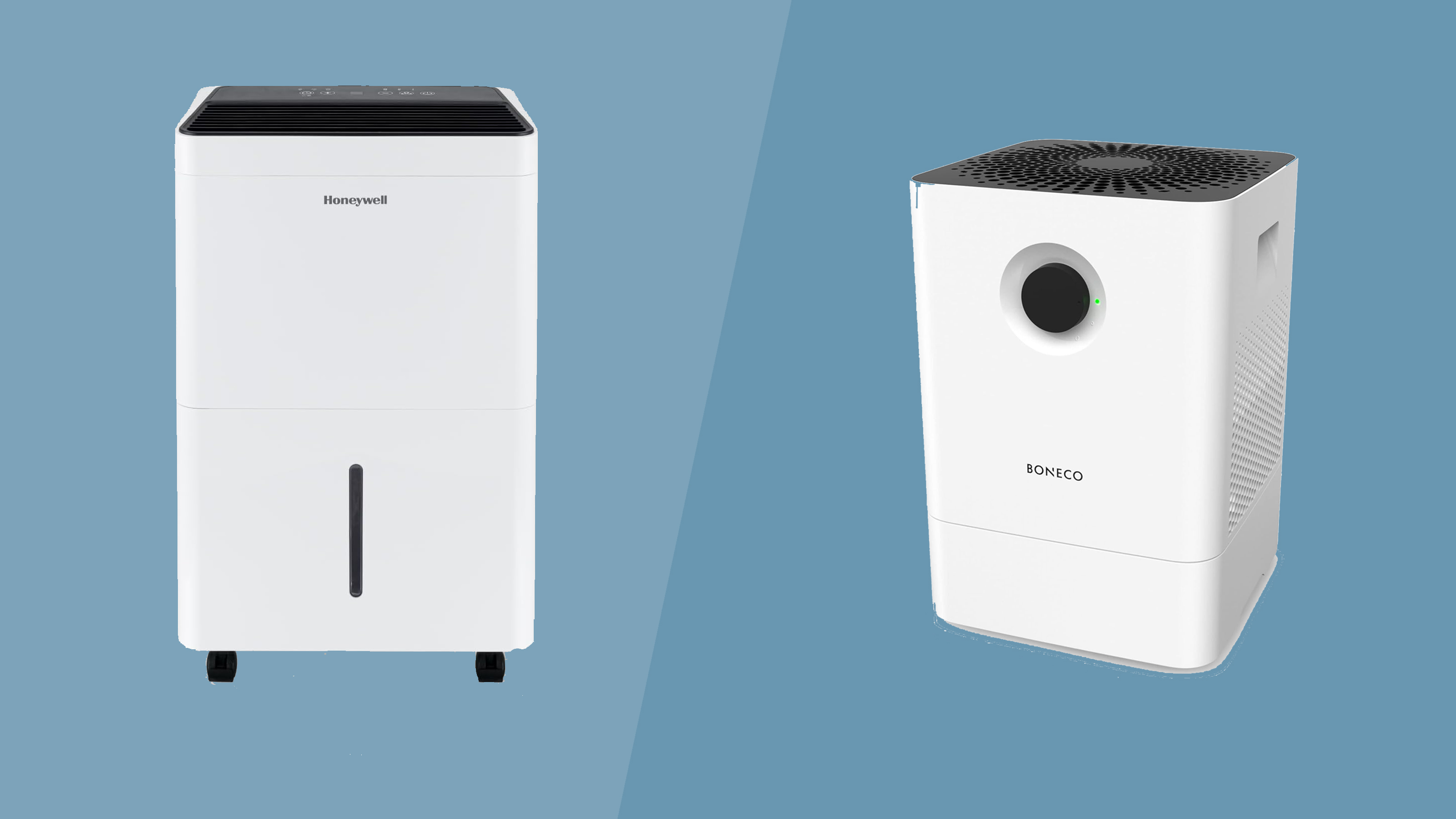If your home is too humid or dry, knowing the difference between a dehumidifier and a humidifier (and when to bring one or the other into your home) can be game-changing.
When the air quality at home is too humid, you may be battling mold or dampness. On the other hand, if it’s too dry, common complaints include nasal congestion, dry eyes, and cracked wood.
The best dehumidifiers can help you strike the right balance by extracting moisture from the air. They release dry air into the home, making them particularly effective in hot and humid climates. The best humidifiers do the opposite, adding moisture back into the air.
The Centers for Disease Control and Prevention (CDC) recommends keeping your home or office humidity levels between 30 and 50%. We also confirmed this with our expert, Mike Feldstein, a wildlife smoke and air quality educator from Austin, Texas.
With his expert advice, let us break down the key differences between dehumidifiers and humidifiers and exactly when you should use each appliance in your home.
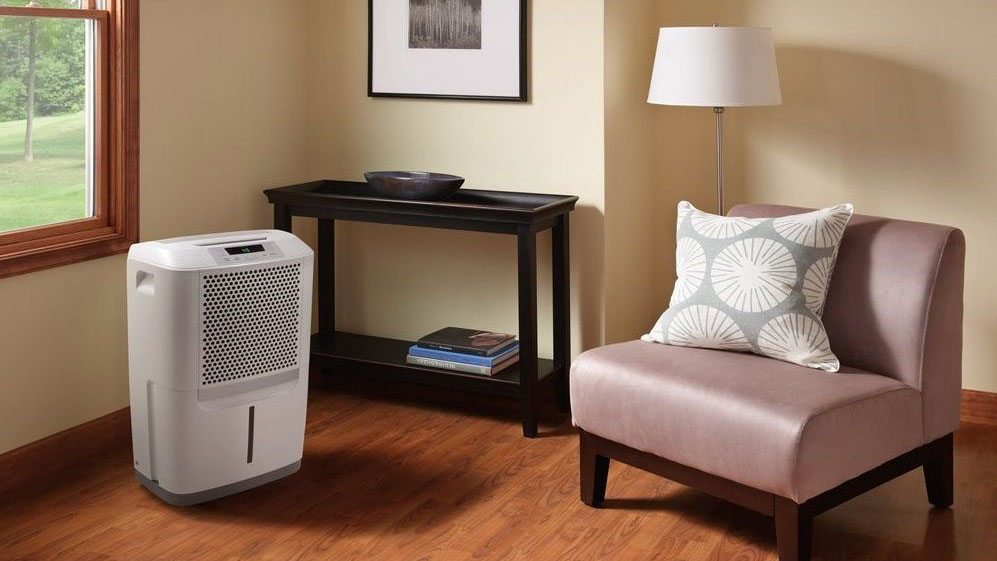
Dehumidifier vs humidifier: Price and value
There is very little difference in the price of a dehumidifier and a humidifier until you consider the ongoing costs required to keep a humidifier running.
You don't need to spend more than $50 on a basic dehumidifier that can handle a small space, such as a closet or bathroom. However, larger and more powerful models cost at least double ($100+) but can treat larger spaces like a kitchen.
Like dehumidifiers, humidifiers typically cost $40 to $200. The basic Vicks Mini Cool Mist Humidifier costs under $50, whereas more premium models from Honeywell, Boneco, or Vicks cost up to $200. Ideally, a capable six-liter model should cost around $120.
Of course, buying a whole-house humidifier is a different story. The cost of professional installation can quickly exceed $500.
As with most home appliances, the more premium features your dehumidifier or humidifier has (such as smart settings or an Energy Star certification), the more expensive it will be. The higher the wattage, the higher your energy bills will be, too.
So, why are humidifiers more expensive overall? It all boils down to the maintenance costs. Typically, home humidifiers need regular filter changes and a new evaporator pad once per year. Replacing an evaporator pad costs $20 to $60 each time.
Dehumidifiers can be emptied and cleaned by hand with soap and warm water once weekly to prevent mold or mildew growth. Once per season, you should clean the intake and exhaust grills with a brush and hoover.
Remember, if your dehumidifier or humidifier doesn’t come with a built-in humidistat, purchasing a house humidistat will cost $60 to $100. Without a humidistat to monitor humidity levels, you risk making your air too humid or dry.
Dehumidifier vs humidifier: Features and functions
Our expert, Mike Feldstein, helpfully points out that although dehumidifiers and humidifiers balance humidity levels, they use very different mechanisms.
“Dehumidifiers remove excess moisture from the air, reducing mold and mildew risk. They help bring the humidity back within the normal range (30 - 50%), especially in humid climates or damp areas like bathrooms and laundry rooms, where there's a lot of moisture to remove.
“On the other hand, humidifiers add moisture to counteract dry conditions, which is useful during winter when heating systems can reduce indoor humidity to as low as 10%," Mike explains.
There are two main types of portable dehumidifiers:
A refrigerant dehumidifier passes air over a cold evaporator surface, collecting moisture in a water tank before releasing dry air into the home.
A desiccant dehumidifier uses a rotating wheel to soak up moisture from the air before collecting it in a tank. It is more expensive to produce, so it is less popular.
The larger the water tank, the more water your dehumidifier can hold before it empties, making it suitable for a larger space. If you don't want to empty the tank, choose a dehumidifier with an integrated pump instead.
Desirable features include extra fan speeds, smart features such as Wi-Fi, and an auto shut-off feature to prevent leakages.
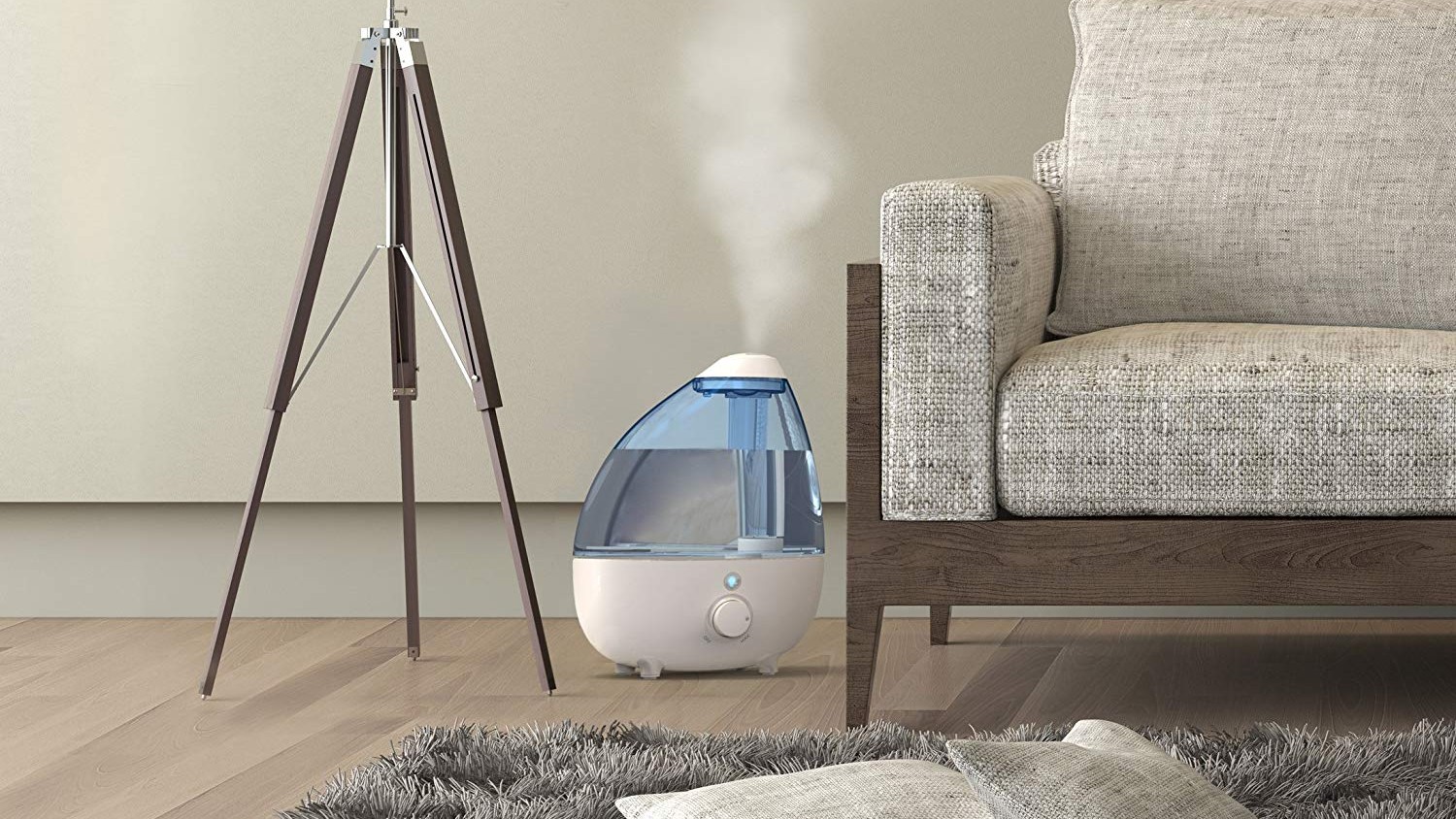
That brings us to humidifiers. A handful of different humidifier designs exist, although only a few are common for the home.
Evaporative humidifiers are the most common type. They move air through a wet surface before releasing a cold, wet mist. The wick needs to be replaced regularly, and it costs around $10 each time.
Ultrasonic humidifiers also release a cold mist. However, they use a vibrating element to form the water droplets, and these models typically use less energy.
Steam vaporizer humidifiers are only recommended for homes without children or pets. They use a heated element to boil water and release a warm mist.
Similarly to dehumidifiers, the larger the water tank, the larger the space your humidifier can handle.
An auto-shut-off feature is especially important for humidifiers. If the device continues working when the water tank is empty, the motor can overheat and start an electrical fire.
Lastly, there are a handful of optional features, such as varied fan speeds, timers, dual nozzles, and digital displays. Some models, such as the Honeywell HCM-350 Humidifier, also use ultraviolet light to kill bacteria.
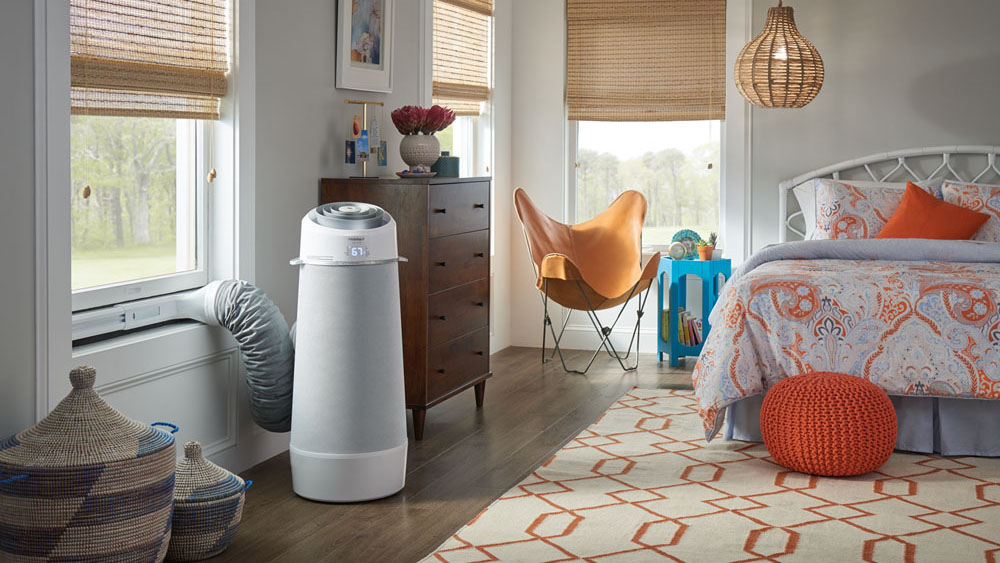
Dehumidifier vs humidifier: Performance
Homeowners often use dehumidifiers as a first-line defense against mold and mildew, especially in bathrooms. But how effective are they?
One thing is for sure: dehumidifiers can’t eliminate humidity. However, they are very effective at keeping moisture levels between 30 and 50% safe as long as they are set to the correct level and kept running.
Of course, this depends on whether your dehumidifier is large enough for your space.
Humidifiers also perform well when used in a proportionate space. Adding moisture to a very dry home can help to improve cold symptoms and prevent dry skin, eyes, and nosebleeds.
However, if you don't maintain your humidifier properly, you may get sick. According to a 2022 study in Shanghai, if ultrasonic humidifiers are not properly maintained, they can promote bacteria growth in the air.
Furthermore, if you place a humidifier next to clothes or bedding, it can add too much moisture to the fabrics, leading to mold growth.
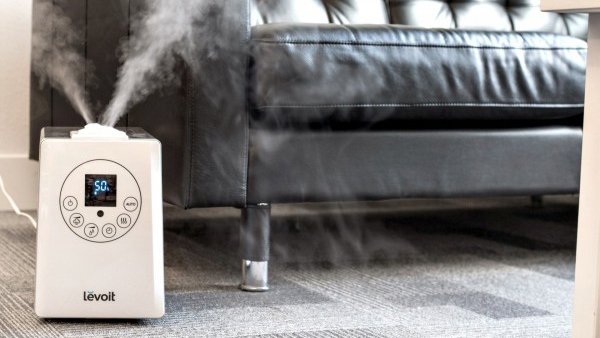
Dehumidifier vs humidifier: What the experts say

Based in Austin, Texas, Mike Feldstein is a wildfire smoke and air quality educator with more than 10 years of experience. He’s also the founder of Jaspr, a company dedicated to improving indoor air quality.
Our expert, Mike Feldstein, has 10+ years of experience as a wildfire smoke and air quality educator. He points out that choosing between a dehumidifier and a humidifier usually depends on where you live and your home challenges.
“If you are located in a place with a warmer climate, especially near a water source, and you notice mold around your house, you'll need a dehumidifier, but if you are in a cold environment where the air is dry, a humidifier is the way to go.”
Interestingly, what homeowners are looking for is also constantly evolving. “There is a growing trend towards smart home technology,” Mike explains.
“Consumers now prefer devices that offer smart features, such as app connectivity, air quality monitoring, and automated adjustments based on real-time conditions.”
Hybrid devices offering dehumidifying, humidifying, and even air purifying all in one are also growing in popularity.
Dehumidifier vs humidifier: FAQs
When should you not use a humidifier or dehumidifier?
The CDC estimates that safe humidity levels for the home are between 30 and 50%. Therefore, if your humidistat is already registering readings within this percentile, you probably don't need to invest in a dehumidifier or humidifier.
You should also avoid using one of these appliances if it is old and not well-maintained. Poorly maintained humidifiers can release mold spores, bacteria, and other pollutants into the air.
If you have severe asthma or allergies, it’s also best to consult with your doctor before you start experimenting with home air quality.
How do I know what size humidifier or dehumidifier to use?
When choosing the size of your dehumidifier or humidifier, room size is the main consideration. For a small room of 300 to 400 square feet, your dehumidifier should be able to hold at least 10 to 20 pints of water per day, while a humidifier should hold at least 10 to 15 pints of water.
For a larger room, a dehumidifier should be able to hold 20 to 40 pints of water. A humidifier should also have a 20- to 30-pint capacity.
To measure the square footage of a room, multiply the length and width together. Most appliances will specify which room size they are designed for on the packaging.
What is the ideal humidity level for a home?
According to the CDC and our expert Mike Feldstein, the ideal humidity levels for a home are between 30 and 50%. Any more or less, and you risk damaging your home or even your health.
Will a dehumidifier remove mold?
While a dehumidifier can help prevent mold growth, it won’t remove existing mold. The only way to get rid of mold completely is to use a natural or chemical solution containing ingredients such as bleach or white vinegar.
Dehumidifier vs humidifier: which is better?
The bottom line is that dehumidifiers and humidifiers are handy additions to the home if you want to keep your humidity levels between 30 and 50%.
While dehumidifiers will reduce humidity levels by extracting and collecting moisture in a tank, humidifiers have the opposite effect, adding moisture back into the air.
When buying either, the larger the tank size, the greater the space it can handle. Many models share similar features, such as smart settings, varied fan speeds, and digital displays. Hybrid models are also increasing in popularity, making it easier to control your home's humidity levels all year round.
